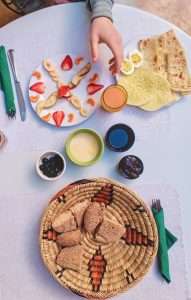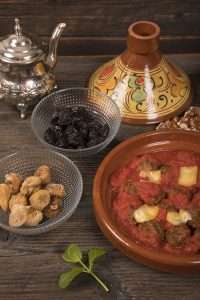Moroccan Cuisine - A Gastronomic Journey
Immerse Yourself in Moroccan Cuisine: A Gastronomic Journey
Introduction: Moroccan Cuisine
Travel to Morocco for a gastronomic journey and experience the country’s diverse cuisine, fragrant spices, and vibrant culinary traditions. Moroccan food is an authentic representation of the nation’s rich cultural history since it combines Berber, Arab, and Mediterranean elements into a delicious symphony.
We cordially welcome you to discover the captivating world of Moroccan cuisine on this delightful culinary trip. Morocco provides a treasure trove of gastronomic delicacies that will captivate your senses and leave an ever-lasting impression on your palette, ranging from spicy tagines and aromatic couscous to delicate pastillas and rich pastries.
Join us as we explore the mix of tastes, essential ingredients, and iconic dishes that make Moroccan cuisine unique. We’ll walk you through bustling souks where the air is fille with the brilliant hues of spices, teach you how to make Moroccan tea, and reveal the techniques behind age-old family recipes.
Moroccan cuisine will knock you off your feet with its strong tastes, mouthwatering scents, and the warm embrace of its hospitality, whether you’re a seasoned foodie or an inquisitive visitor looking for new culinary experiences. So be ready to embark on an incredible adventure with your taste senses as we explore the essence of Moroccan food.
Moroccan Cuisine: A Fusion of Flavors and Influences
Overview of Moroccan cuisine and its key characteristics:
- Talk about Morocco’s diverse cultural history and its role as a crossroads for civilizations.
- Draw attention to the many influences of the Mediterranean, Arab, and Berber culinary traditions.
Highlight the fusion of flavors from Berber, Arab, and Mediterranean influences:
- Explore the usage of fragrant spices in Moroccan cuisine, such as cinnamon, coriander, and cumin.
- Talk about how to blend sweet and salty flavors while frequently include dried fruit and nuts.
Emphasize the use of aromatic spices and herbs in Moroccan dishes:
- Showcase the significance of ingredients like paprika, saffron, and turmeric in Moroccan cooking.
- In order to give foods a fresh and complex flavor, talk about using fresh herbs like mint, cilantro, and parsley.
Staple Ingredients in Moroccan Cooking
Highlight key staple ingredients in Moroccan cuisine:
- The significance of foods like couscous, which is the base of many Moroccan cuisines, should be discusse.
- Mention how fragrant oils, like argan oil, are frequently using in Moroccan cookery.
Explain why items like tagine and preserved lemons are important:
- Describe the ancient technique of flavor-infusing slow cooking in a tagine pot that results in soft, luscious food.
- Emphasize the value of preserved lemons, which give Moroccan dishes a distinctive tanginess and complexity.
Emphasize the use of fresh herbs, such as mint and cilantro, in Moroccan dishes:
- Discuss how herbs enhance the flavor, fragrance, and freshness of various Moroccan foods.
- Mention famous herbal foods like tabbouleh salad and Moroccan mint tea.
Signature Moroccan Dishes and Delicacies
Highlight popular Moroccan dishes like tagine, couscous, and pastilla:
- Outline the history and importance of these Moroccan meals.
- Describe the components, tastes, and preparation methods used to make each dish.
Talk about the regional variances, tastes, and ingredients used in these dishes:
- Learn about the many sorts of tagines, such as lamb with prunes and almonds or chicken with preserved lemons and olives.
- Draw attention to the many couscous varieties, such as veggie couscous and couscous with lamb or chicken.
- Describe the subtle nuances of the pastilla’s layers of flavor, which are layered savory and sweet pastries packed with spiced pork and nuts.
Highlight lesser-known foods like b’stilla, harira, and mechoui:
- Describe the classic Moroccan pie known as b’stilla, which is layered with chicken or pigeon, almonds, and flavorful spices.
- Talk about harira, a substantial soup composed with lentils, chickpeas, and flavorful herbs that is frequently eaten during Ramadan.
- Emphasize mechoui, a delicious roasted lamb meal frequently eaten at special events and holidays.
Exploring the Flavors: Moroccan Spices and Condiments
Discuss the variety of spices used in Moroccan cuisine, including cumin, cinnamon, and saffron:
- Draw attention to the significance that spices play in improving the tastes and scents of Moroccan cuisine.
- Discuss the value of utilizing premium spices to get true Moroccan tastes.
Stress the value of spice mixtures like chermoula and ras el hanout:
- Describe the ingredients and significance of ras el hanout, an intricate mixture of flavorful spices used in Moroccan cuisine.
- Discuss chermoula, a flavorful marinade made of herbs and spices that is frequently applied to fish and grilled meats.
Mention a few classic condiments, such harissa and preserved lemons:
- Talk about the spicy, tasty harissa paste that is prepared from chili peppers, spices, and garlic.
- Draw attention to the sour and tart preserved lemons that give Moroccan meals a distinct flavor.
Moroccan Street Food: A Delight for the Senses
Showcase the vibrant street food culture in Morocco:
- Draw attention to the lively street markets and food stands that sell a broad range of mouthwatering foods.
- Talk about the vibrant and fragrant ambiance of Moroccan street food scenes.
Emphasize well-known Moroccan street foods including grilled meats, fried snacks, and sandwiches (khobz):
- Talk about khobz, a type of traditional Moroccan bread that is frequently stuffed with grilled meats, veggies, and savory sauces.
- Draw attention to the mouthwatering grilled meats, such as kebabs and merguez sausages, which are frequently served in sandwiches or on skewers.
- Mention maakouda, a well-known fried potato snack that has a crunchy outside and a soft inside.
Discuss the unique flavors and experiences of indulging in Moroccan street food:
- Highlight the strong, aromatic tastes that come from the spices and marinades used in the production of street cuisine.
- Describe the sensation of eating street cuisine while surrounded by the bustling Moroccan marketplaces’ sounds, sights, and scents.
Traditional Moroccan Tea: A Ritual of Hospitality
The significance of Moroccan mint tea in Moroccan culture
- The importance of tea in Moroccan hospitality and social events should be explained.
- Emphasize the significance of serving and enjoying tea as a sign of genuine welcome.
How Moroccan tea is made and served:
- The process for making Moroccan mint tea using fresh mint leaves, sugar, and loose green tea leaves.
- Talk about the method for pouring tea from a height to produce a foamy and fragrant brew.
Draw attention to the part tea plays in Moroccan hospitality and social gatherings:
- Talk about the etiquette and traditions that go along with serving and consuming Moroccan tea, such as utilizing tiny cups and pouring from a teapot.
- In Moroccan culture, sipping tea is a social activity that encourages interaction and discussion.
Conclusion
Congratulations! Your voyage through the alluring realm of Moroccan food will be filled with delicious flavors. You now have a better understanding of the rich culinary tapestry that characterizes this exceptional cuisine, from the confluence of tastes and fragrant spices to the hallmark dishes, street food pleasures, and the beloved custom of Moroccan tea.
Moroccan cuisine blends Berber, Arab, and Mediterranean traditions into a harmonic symphony of flavors as a celebration of cultural variety. Each taste reveals a tale of Morocco’s rich heritage and culinary expertise, whether you’re savoring a fragrant tagine, admiring the delicate layers of a pastilla, or taking in the bustling ambience of street food markets.
To really appreciate the creativity and methods used to create these mouthwatering meals, think about immersing yourself in practical activities like cooking courses and culinary tours as you continue to learn about Moroccan cuisine. Spend some time exploring crowded markets, talking to merchants, and finding the fresh ingredients that are the foundation of Moroccan cuisine.
Keep in mind that Moroccan food is flexible and tolerant, providing choices for different dietary preferences and requirements. Moroccan food may be modified to fit your tastes and preferences, regardless of whether you are a vegetarian, vegan, or have certain nutritional demands.
So let Moroccan food transport you to a location where you may fully engage your senses and culture. Whether you’re on a culinary tour through the winding streets of Marrakech or unwinding in a local riad and taking advantage of Moroccan hospitality, the culinary treasures of Morocco are simply waiting to be discovered and savored.
Enjoy your culinary journey through the flavors of Morocco! Moroccan Cuisine
Immerse Yourself in Moroccan Cuisine: A Gastronomic Journey


Immerse Yourself in Moroccan Cuisine
Note : If you need a city Tour or a trip Let us know, The Tour Can be Customized Depending on your Needs ( Time , Dates , pick up and drop off locations…ect)
Whether you’re traveling as a couple, a small group of friends or family, whether you crave history, adventure, culinary delights or a peaceful getaway, we can help you create the dream holiday at your dream destination. Contact us
